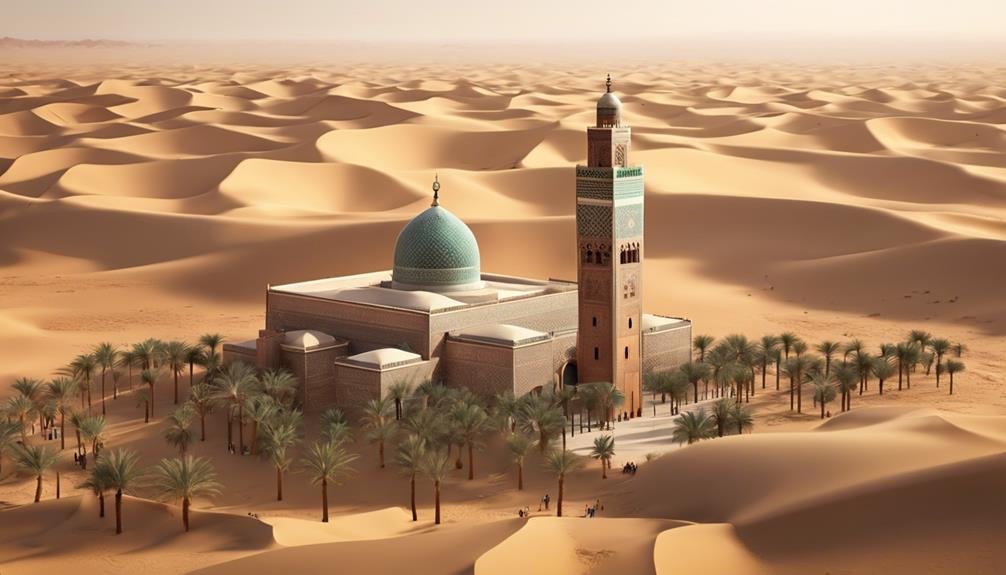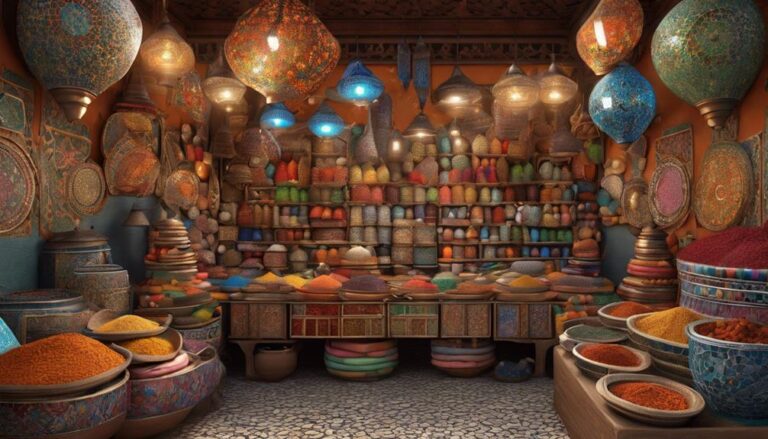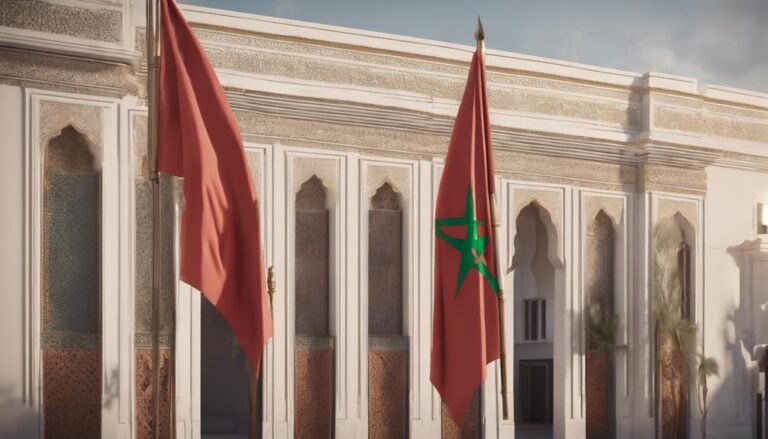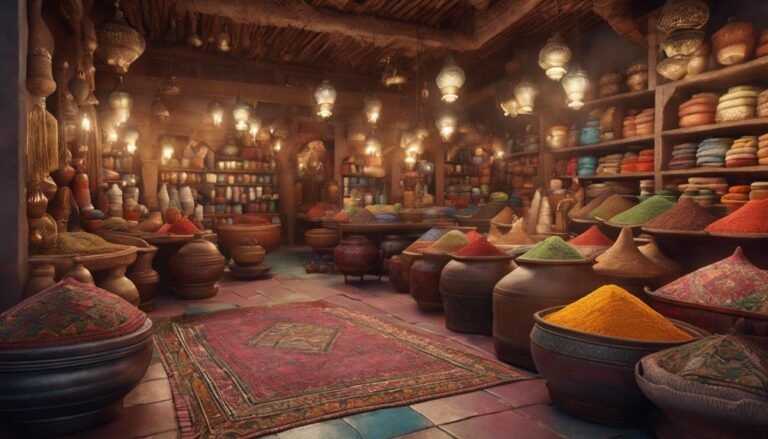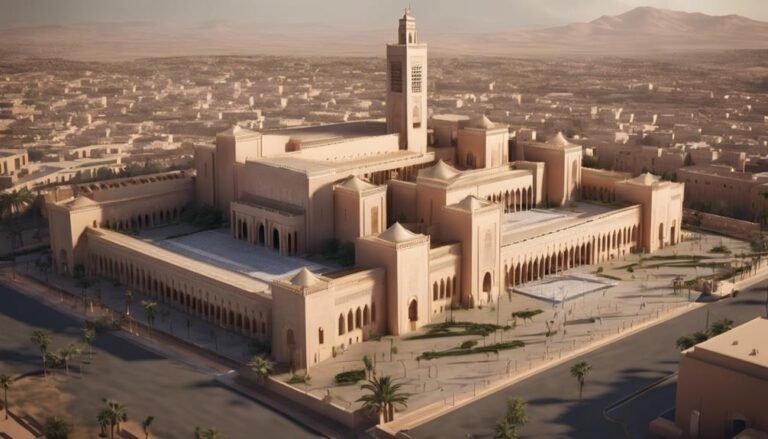Explore Morocco's UNESCO World Heritage Sites like the historic city of Meknes, showcasing Islamic and European architecture. Navigate the Medina of Fez's labyrinthine alleys and diverse architectural styles. Discover the cultural crossroads of Ksar of Ait-Ben-Haddou and the historical significance of the Portuguese City of Mazagan. Unearth the Roman ruins at the Archaeological Site of Volubilis. Witness the Medina of Marrakesh's urban preservation efforts and Rabat's blend of modernity and heritage. Feel the artistic vibe in the Medina of Essaouira. Morocco's sites offer a journey through time and culture, revealing the nation's rich history and architectural diversity.
Key Takeaways
- Historic City of Meknes: Blend of Islamic and European architecture, vibrant souks, example of ancient city evolution.
- Medina of Fez: Oldest continuously inhabited medieval city, diverse architectural styles, balancing preservation with modernization.
- Ksar of Ait-Ben-Haddou: Southern Moroccan architecture, cultural crossroads, living testament of Morocco's legacy.
- Portuguese City of Mazagan: Reflects European and Moroccan influences, historical significance as a former Portuguese stronghold.
- Archaeological Site of Volubilis: Rich historical significance, Roman ruins showcasing advanced engineering, conservation efforts for future generations.
Historic City of Meknes
Nestled in the heart of Morocco, the Historic City of Meknes beckons visitors with its ancient walls and bustling markets. This UNESCO World Heritage Site is a reflection of the cultural traditions and urban development of the region. Meknes, founded in the 11th century, showcases a blend of Islamic and European architectural styles, revealing the diverse influences that have shaped the city over the centuries.
Cultural traditions run deep in Meknes, evident in its vibrant souks, where locals and tourists alike can immerse themselves in the sights, sounds, and smells of traditional Moroccan crafts and cuisine. The city's rich history is also preserved in its numerous museums and historical sites, offering a glimpse into the past way of life in this bustling urban center.
In terms of urban development, Meknes stands as a prime example of how ancient cities can evolve while still maintaining their unique character. The city's layout, with its intricate network of narrow streets and grand squares, speaks to a time when meticulous planning and architectural prowess were paramount in creating a thriving urban hub. Today, Meknes continues to attract visitors from around the world, drawn to its timeless charm and historical significance.
Medina of Fez
With its maze-like streets and ancient architectural marvels, the Medina of Fez stands as a tribute to Morocco's rich cultural heritage and historical significance. This UNESCO World Heritage Site is a vibrant hub of activity, offering a glimpse into a bygone era while still pulsating with life. Here's a closer look at what makes the Medina of Fez a cultural gem:
- Cultural Traditions: The winding alleys of the Medina are lined with traditional artisan workshops where craftsmen practice age-old techniques, such as pottery, metalwork, and textile production.
- Architectural Diversity: The Medina boasts a diverse range of architectural styles, from intricate tile work to ornate wooden carvings, showcasing the cultural fusion that defines Moroccan artistry.
- Historic Importance: As one of the oldest continuously inhabited medieval cities in the world, the Medina of Fez is a validation to the resilience of its inhabitants and their commitment to preserving their heritage.
- Urban Development Challenges: Balancing the preservation of cultural heritage with modern urban development requirements poses a continuous challenge, making the conservation efforts in the Medina of Fez critical for its sustainability and future relevance.
Ksar of Ait-Ben-Haddou
The Ksar of Ait-Ben-Haddou, a striking example of southern Moroccan architecture, showcases a unique blend of earthen construction techniques and cultural heritage. This UNESCO World Heritage Site holds immense cultural significance, serving as a testament to the traditional way of life in the region. The ksar, or fortified village, is a cluster of earthen buildings surrounded by high walls, exemplifying the architectural marvels of the area. The intricate mud-brick structures, adorned with decorative motifs and geometric patterns, reflect the craftsmanship and ingenuity of the local Berber people.
The Ksar of Ait-Ben-Haddou hasn't only preserved these architectural treasures but also provides a glimpse into the historical and cultural context of southern Morocco. Its strategic location along ancient trade routes highlights its importance as a cultural crossroads. Visitors are captivated by the authenticity and charm of this well-preserved site, where each building tells a story of the past. The ksar stands as a living testament to the rich heritage and architectural legacy of Morocco.
Archaeological Site of Volubilis
When exploring the Archaeological Site of Volubilis, you'll be amazed by its rich historical significance.
The ruins at Volubilis offer a glimpse into the ancient Roman presence in Morocco and the cultural exchange that took place.
Conservation efforts at Volubilis guarantee that future generations can appreciate and learn from this important archaeological site.
Historical Significance of Volubilis
Having stood the test of time, the Archaeological Site of Volubilis in Morocco bears witness to the rich historical significance of the ancient Roman city. The Roman ruins at Volubilis offer a glimpse into the architectural marvels of the past, showcasing the advanced engineering and urban planning of the time.
The intricate mosaics found within the site provide insights into the daily life and cultural practices of the ancient inhabitants. The well-preserved structures, such as the triumphal arch and the Capitol, highlight the city's political and religious importance in antiquity.
The ongoing archaeological excavations continue to reveal new layers of history, deepening our understanding of this ancient culture.
- Roman ruins showcasing advanced engineering
- Detailed mosaics offering insights into daily life
- Well-preserved structures like the triumphal arch and Capitol
- Ongoing excavations expanding knowledge of ancient culture
Preservation Efforts at Volubilis
Efforts to preserve the Archaeological Site of Volubilis in Morocco are essential for safeguarding its historical legacy and ensuring its longevity for future generations. The archaeological preservation initiatives at Volubilis focus on maintaining the site's structural integrity, protecting its ancient artifacts, and promoting cultural restoration.
Through meticulous excavation, documentation, and conservation practices, experts work diligently to uncover the rich history of Volubilis while also preventing further deterioration of its ruins. Cultural restoration efforts aim to revive the site's original splendor, providing visitors with a glimpse into the past glory of this ancient Roman city.
Medina of Marrakesh
Nestled within the bustling city of Marrakesh lies the enchanting UNESCO World Heritage Site, the Medina of Marrakesh. This ancient walled city is a treasure trove of history and culture, offering a glimpse into Morocco's rich past and traditional way of life.
- Cultural Preservation: The preservation efforts in the Medina of Marrakesh are vital in maintaining its authenticity and historical significance. Various restoration projects guarantee that the traditional architecture and craftsmanship are safeguarded for future generations.
- Urban Development: Balancing modernization with the preservation of the old town is a delicate task. The challenge lies in enhancing infrastructure and facilities for residents and visitors while respecting the Medina's unique character and heritage.
- Tourism Impact: The influx of tourists brings economic opportunities to the Medina, but it also poses challenges such as overcrowding and commercialization. Sustainable tourism practices are essential to protect the site from overexploitation.
- Community Engagement: Involving the local community in decision-making processes and tourism initiatives fosters a sense of ownership and pride. Empowering residents to benefit from tourism activities can lead to sustainable development and cultural exchange within the Medina.
Portuguese City of Mazagan
The Portuguese City of Mazagan, now known as El Jadida, stands as a proof to a rich historical past. Its architectural features showcase a blend of European and Moroccan influences, reflecting centuries of cultural exchange.
Preservation efforts in Mazagan highlight the importance of safeguarding this unique site for future generations.
Historical Significance of Mazagan
With its strategic location along the Atlantic coast, Mazagan holds a unique historical significance as a former Portuguese stronghold in Morocco.
The city's historical importance is evident through archaeological excavations that have uncovered remnants of its past, highlighting its cultural significance.
UNESCO recognition has played a crucial role in preserving Mazagan's heritage, leading to ongoing historical preservation efforts aimed at safeguarding its rich history for future generations to appreciate.
The blend of Portuguese and Moroccan influences in Mazagan's history adds depth to its significance, making it a compelling site for those interested in exploring the intersection of different cultures and histories.
Architectural Features of Mazagan
Among the architectural features that define the Portuguese City of Mazagan are its distinctive fortifications and ornate Manueline-style detailing, showcasing a blend of military and decorative elements that reflect the city's historical significance.
The fortifications, with their sturdy walls and bastions, not only served defensive purposes but also stood as symbols of power and control. The Manueline architectural style, characterized by intricate carvings, maritime motifs, and delicate ornamentation, illustrates the cultural influences of the time.
These architectural elements have been meticulously preserved over the centuries, offering visitors a glimpse into the rich history of Mazagan and the intricate craftsmanship of its builders. The fusion of military functionality with artistic embellishments demonstrates the city's strategic importance and architectural legacy.
Preservation Efforts in Mazagan
Efforts to preserve the architectural heritage of Mazagan showcase a commitment to safeguarding its historical significance for future generations. Mazagan faces conservation challenges due to its age and exposure to coastal elements, prompting significant restoration efforts to maintain its authenticity.
The city's cultural significance lies in its fusion of European and Moroccan architectural styles, reflecting a unique historical period of cultural interchange. These preservation endeavors not only protect the city's heritage but also have a positive impact on tourism by attracting visitors interested in exploring a well-preserved example of Portuguese colonial architecture in North Africa.
- Conservation challenges due to age and coastal exposure
- Ongoing restoration efforts to maintain authenticity
- Cultural significance in blending European and Moroccan styles
- Tourism impact through attracting visitors intrigued by well-preserved heritage
Rabat, Modern Capital and Historic City
Nestled on the Atlantic coast of Morocco, Rabat stands as a fascinating blend of modernity and rich historical heritage. The city's UNESCO World Heritage status is well-deserved due to its unique cultural fusion and architectural marvels.
Walking through Rabat's streets, you'll be struck by the juxtaposition of ancient landmarks like the Kasbah of the Udayas and the Hassan Tower against the backdrop of contemporary buildings and vibrant urban life. The Kasbah, with its narrow alleyways and whitewashed walls, reflects the city's Andalusian influence, while the unfinished Hassan Tower, dating back to the 12th century, offers a glimpse into Rabat's historic grandeur.
Rabat's modern capital status is evident in its wide boulevards, government buildings, and bustling markets, creating a dynamic atmosphere that seamlessly integrates the past with the present. The city's architectural landscape showcases a harmonious blend of Moorish, Almohad, and French colonial styles, making Rabat a true gem for history enthusiasts and architecture aficionados alike.
Medina of Essaouira (formerly Mogador)
The Medina of Essaouira, formerly known as Mogador, offers a mesmerizing journey through Morocco's coastal history and architectural charm, distinct from Rabat's blend of modernity and ancient allure. This UNESCO World Heritage Site stands out for its coastal charm and cultural fusion, reflecting a unique blend of Arab, Berber, and European influences. The town's layout, with its distinctive blue and white buildings and narrow streets, showcases a harmonious mix of architectural styles that symbolizes its rich history.
- Coastal Charm: Essaouira's location on the Atlantic coast provides a serene backdrop for its historic medina, creating a peaceful atmosphere for visitors to explore.
- Cultural Fusion: The medina's architecture and design reflect the diverse cultural influences that have shaped Essaouira over the centuries.
- Artistic Enclave: Essaouira has long been a haven for artists and creatives, drawn to its inspiring surroundings and vibrant atmosphere.
- Maritime History: As a former port city, Essaouira's maritime history is deeply ingrained in its identity, evident in the old port and fortifications that still stand today.
Conclusion
You've now explored the UNESCO World Heritage sites in Morocco, each offering a unique glimpse into the country's rich history and cultural significance.
From the ancient ruins of Volubilis to the vibrant medinas of Fez and Marrakesh, these sites showcase the diverse heritage of Morocco.
Whether you're a history buff, architecture enthusiast, or simply a curious traveler, these sites will surely leave you in awe of Morocco's fascinating past.
Start planning your visit to these remarkable sites today!

The Editorial Team is a passionate group of Morocco enthusiasts dedicated to sharing the beauty, culture, and wonders of this captivating country. With diverse backgrounds and a deep love for travel, we strive to bring you engaging and informative content that inspires your Moroccan adventures. From uncovering hidden gems and sharing local insights to exploring mouthwatering cuisine and showcasing the vibrant lifestyle, our team is committed to providing you with valuable resources and exciting stories that enhance your exploration of Morocco. Join us on this journey as we celebrate the rich heritage and unforgettable experiences that make Morocco truly special.

